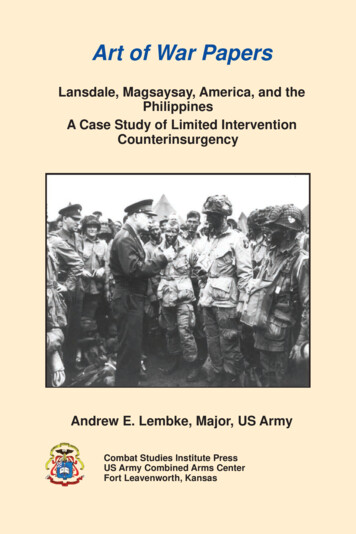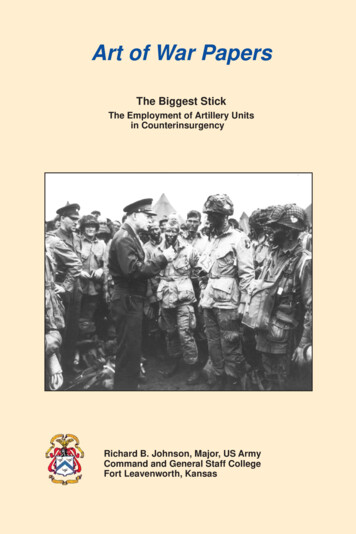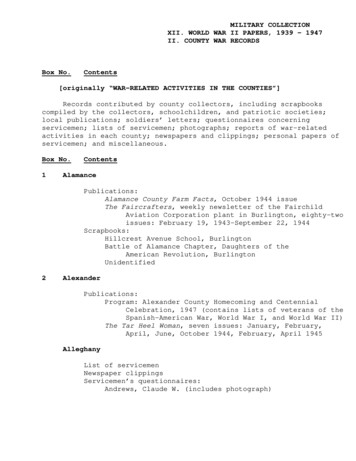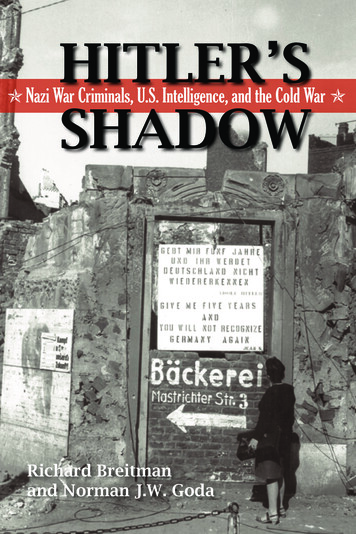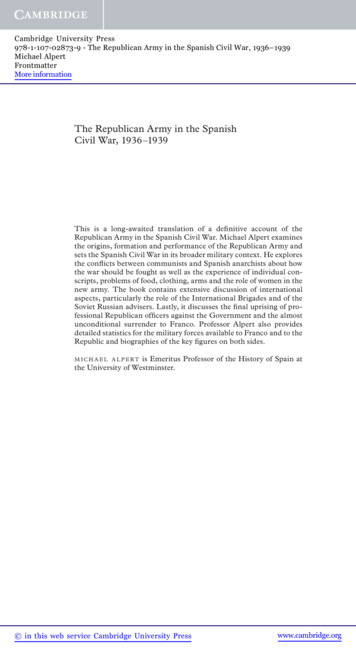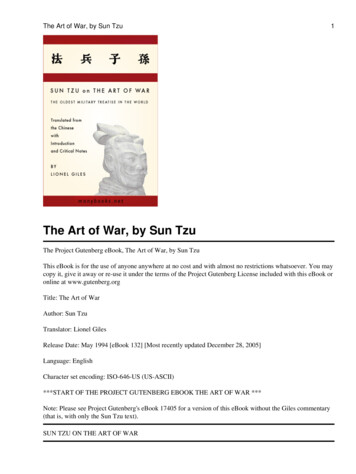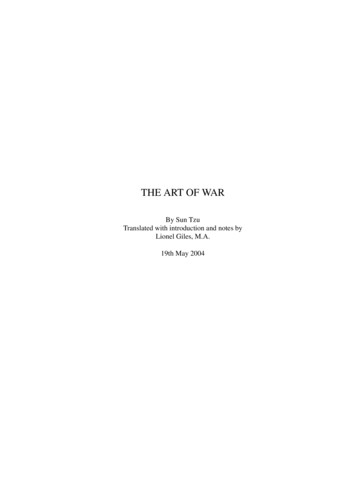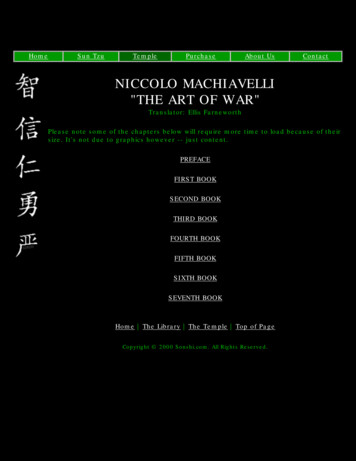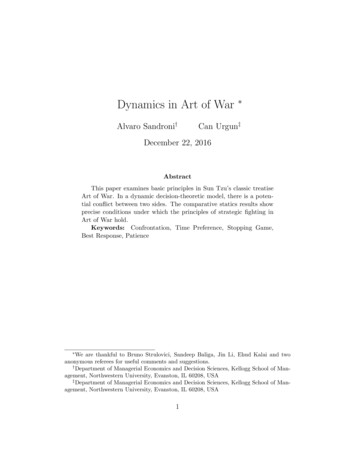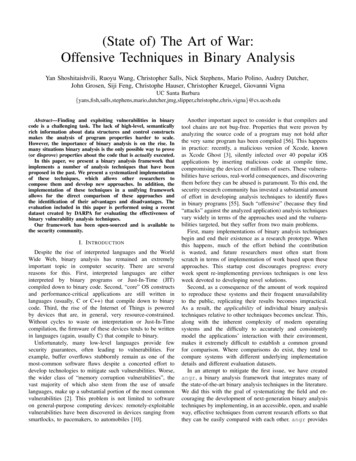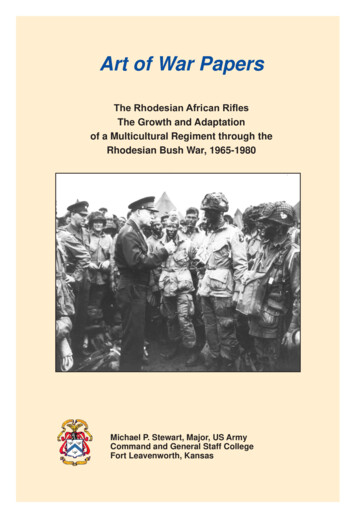
Transcription
Art of War PapersThe Rhodesian African RiflesThe Growth and Adaptationof a Multicultural Regiment through theRhodesian Bush War, 1965-1980Michael P. Stewart, Major, US ArmyCommand and General Staff CollegeFort Leavenworth, Kansas
The cover photo courtesy of the Library of Congress is that of GeneralDwight Eisenhower giving orders to American paratroopers in England.
The Rhodesian African RiflesThe Growth and Adaptationof a Multicultural Regiment through theRhodesian Bush War, 1965-1980A Thesis Presented To the Faculty of the US ArmyCommand and General Staff College in PartialFulfillment of the Requirements For TheDegreeMaster of Military Art and ScienceMilitary HistorybyMichael P. Stewart, Major, US ArmyB.S., The Citadel, Charleston, South Carolina, 1998Fort Leavenworth, Kansas2011-02
Library of Congress Cataloging-in-Publication DataStewart, Michael P.The Rhodesian African Rifles : the growth and adaptation of amulticultural regiment through the Rhodesian Bush War, 1965-1980 / byMichael P. Stewart, Major, US Army.pages cmM.A. US Army Command and General Staff College 20121. Southern Rhodesia. Army. Rhodesian African Rifles--History. 2.Zimbabwe--History, Military--20th century. 3. Zimbabwe--History-Chimurenga War, 1966-1980. I. Title. II. Title: Growth and adaptation ofa multicultural regiment through the Rhodesian Bush War, 9632012Combat Studies Institute Press publications covera wide variety of military history topics. The viewsexpressed in this CSI Press publication are those of theauthor(s) and not necessarily those of the Departmentof the Army or the Department of Defense. A full listof CSI Press publications available for downloadingcan be found at http://usacac.army.mil/CAC2/CSI/index.asp.The seal of the Combat Studies Institute authenticates this document asan official publication of the CSI. It is prohibited to use CSI’s officialseal on any republication without the express written permission of theDirector of CSI.EditorC. Fischerii
AbstractThe Rhodesian African Rifles: The Growth And Adaptation OfA Multicultural Regiment Through The Rhodesian Bush War,1965-1980, Major Michael P. StewartThe Rhodesian African Rifles overcame profoundly divisive racial andtribal differences among its members because a transcendent “regimentalculture” superseded the disparate cultures of its individual soldiers andofficers. The RAR’s culture grew around the traditions of the Britishregimental system, after which the RAR was patterned. The soldiers ofthe RAR, regardless of racial or tribal background, identified themselvesfirst as soldiers and members of the regiment, before their individual raceand tribe. Regimental history and traditions, as well as shared hardshipson deployments and training were mechanisms that forced officers andsoldiers to see past differences. The RAR is remarkable because these bondsstayed true through to the end of the war, through incredible pressure onblack Rhodesians to succumb to the black nationalist groups and cast offa government that was portrayed to them as oppressive, racist and hateful.Through the end of the Bush War, 1965-1980, RAR soldiers remainedloyal and steadfast to their regiment, and that must be their legacy. In theend, the values of the government were irrelevant. It was the regiment thatdrew these men in, and their loyalty was more to their comrades and theirheritage than to any particular government or cause.iii
Objectives of the Art of War Scholars ProgramThe Art of War Scholars Program is a laboratory for critical thinking.It offers a select group of students a range of accelerated, academicallyrigorous graduate level courses that promote analysis, stimulate the desirefor life-long learning, and reinforce academic research skills. Art of Wargraduates will not be satisfied with facile arguments; they understandthe complexities inherent in almost any endeavor and develop the toolsand fortitude to confront such complexities, analyze challenges, andindependently seek nuanced solutions in the face of those who would optfor cruder alternatives. Through the pursuit of these outcomes, the Art ofWar Scholars Program seeks to improve and deepen professional militaryeducation.The Art of War Program places contemporary operations (such as thosein Iraq and Afghanistan) in a historical framework by examining earliermilitary campaigns. Case studies and readings have been selected to showthe consistent level of complexity posed by military campaigns throughoutthe modern era. Coursework emphasizes the importance of understandingprevious engagements in order to formulate policy and doctrinal responseto current and future campaigns.One unintended consequence of military history education is thephenomenon of commanders and policy makers “cherry picking”history—that is, pointing to isolated examples from past campaignsto bolster a particular position in a debate, without a comprehensiveunderstanding of the context in which such incidents occurred. This trendof oversimplification leaves many historians wary of introducing thesetopics into broader, more general discussion. The Art of War program seeksto avoid this pitfall by a thorough examination of context. As one formerstudent stated: “The insights gained have left me with more questions thananswers but have increased my ability to understand greater complexitiesof war rather than the rhetorical narrative that accompanies cursory studyof any topic.”Professor Michael Howard, writing “The Use and Abuse of MilitaryHistory” in 1961, proposed a framework for educating military officers inthe art of war that remains unmatched in its clarity, simplicity, and totality.The Art of War program endeavors to model his plan:Three general rules of study must therefore be borne in mind by theofficer who studies military history as a guide to his profession and whowishes to avoid pitfalls. First, he must study in width. He must observe theway in which warfare has developed over a long historical period. Onlyby seeing what does change can one deduce what does not; and as muchas can be learnt from the great discontinuities of military history as fromthe apparent similarities of the techniques employed by the great captainsiv
through the ages .Next he must study in depth. He should take a singlecampaign and explore it thoroughly, not simply from official histories,but from memoirs, letters, diaries. . . until the tidy outlines dissolve andhe catches a glimpse of the confusion and horror of real experience and, lastly, he must study in context. Campaigns and battles are not likegames of chess or football matches, conducted in total detachment fromtheir environment according to strictly defined rules. Wars are not tacticalexercises writ large. They are conflicts of societies, and they can befully understood only if one understands the nature of the society fightingthem. The roots of victory and defeat often have to be sought far from thebattlefield, in political, social, and economic factors which explain whyarmies are constituted as they are, and why their leaders conduct them inthe way they do . It must not be forgotten that the true use of history,military or civil is not to make men clever for the next time; it is to makethem wise forever.Gordon B. Davis, Jr.Brigadier General, US ArmyDeputy Commanding GeneralCAC LD&EDaniel MarstonDPhil (Oxon) FRHistSIke Skelton Distinguished Chairin the Art of WarUS Army Command & GeneralStaff Collegev
AcknowledgmentsThis work would not have been possible without the efforts of manyothers on my behalf. First and always, I must thank my wife, Jennifer,for her unwavering support and sacrifice during the many long hours ofresearch and writing that kept me away from my family. Thanks also toDr. Dan Marston, Dr. Nick Murray, and Dr. Scott Stephenson for yourguidance and counsel, and to my colleagues at the Command and GeneralStaff College Art of War Scholars Program--Eric, Darrell, Mike, Marcus,Art and Half-Pint. I also appreciate the gracious assistance of eminentRhodesian historian, Dr. Richard Wood, who provided maps, insight, andcontinued correspondence throughout this project.I am eternally grateful to the veterans of the Rhodesian Army andRhodesian African Rifles, many of whom I had the privilege of meetingduring the course of this study. These are remarkable men whose hospitality,openness and honesty were tremendous. I only hope this work is adequaterepresentation of a worthy and noble regiment.vi
Table Of ContentsChaptersAbstract. iiiObjectives. ivAcknowledgments. viTable Of Contents. viiAcronyms. viiiChapter 1 Introduction. 1Chapter 2 Why Did They Fight?. 13Chapter 3 Phase One: 1965-1972. 31Chapter 4 Phase Two: 1972-1974. 45Chapter 5 Phase Three: 1974-1977. 65Chapter 6 Phase Four: 1977-1979. 83Chapter 7 Phase Five: April 1979-April 1981. 93Chapter 8 Conclusions. 107Bibliography.115FiguresChapter 1Figure 1. Ready for the Regiment. 9Figure 2. Proud, professional RAR NCOs. 10Chapter 5Figure 1. RAR machine gunner. 70Figure 2. RAR paras waiting for a fireforce call-up. 76Chapter 6Figure 1. Mrs. Rule, the widow of Lieutenant Colonel Kim Rule. 89Chapter 7Figure 1. RAR soldiers at Brady Barracks. 104Chapter 8Figure 1. Map of Rhodesia.110Figure 2. Rhodesian population, 1969.111Figure 3. Rhodesian Security Forces Operational Boundaries.112vii
AMORhAFRLIRNRRSFRSMRRRRAFRRRSAANCSADFSAPviiiSecond In Command (Executive Officer)African National CouncilBritish South Africa PoliceCentral Intelligence OrganizationCommanding OfficerCounterinsurgencyCombined Operations(Frente de Libertaçao de Moçambique) LiberationFront of MozambiqueFront for the Liberation of Zimbabwe(Forças Populares para o Libertaçåo deMoçambique) Popular Forces for the Liberation ofMozambiqueGeneral Officer CommandingJoint Military CommandJoint Operation CentreKing’s African RiflesNorthern Rhodesia RegimentOrganization of African UnityOfficer CommandingOperations Coordination CommitteeObservation PostPolice Anti-Terrorist UnitPatriotic FrontPolice Reserve Air WingPlatoon Warrant OfficerProtected VillageRhodesian Air ForceRhodesian African Rifles(Resistência Nacional Moçambicana) MozambicanNational ResistanceRhodesian Air ForceRhodesian Light InfantryRhodesia Native RegimentRhodesian Security ForcesRegimental Sergeant MajorRhodesia Regiment (after UDI)Royal Rhodesian Air ForceRoyal Rhodesia Regiment (prior to UDI)South African African National CongressSouth African Defence ForceSouth African Police
SASSBTTLUANCUDIWOZANLAZANUZAPUZIPAZIPRASpecial Air ServiceSpecial BranchTribal Trust LandUnited African National CouncilUnilateral Declaration of IndependenceWarrant OfficerZimbabwe African National Liberation ArmyZimbabwe African National UnionZimbabwe African People’s UnionZimbabwe People’s ArmyZimbabwe People’s Revolutionary Armyix
Chapter 1IntroductionDuring 65 years of regimental history, men of different raceswith a common ideal had worked and fought together in a spiritof true comradeship and mutual esteem. In the process, a respectand understanding evolved between them which comes only tomen who face conflict together and which cannot be described.Without exception, all who served with the regiment were proudof it and would testify to the unique and profound effect it had ontheir lives.— Alexandre Binda, Masodja: the History of the Rhodesian AfricanRifles and its Forerunner, the Rhodesia Native RegimentThe Rhodesian African Rifles (RAR) overcame profoundly divisiveracial and tribal differences among its members because a transcendent“regimental culture”-described above as a “common ideal”-superseded thedisparate cultures of its individual soldiers and officers. The RAR’s culturegrew around the traditions of the British regimental system, after whichthe RAR was patterned. The soldiers of the RAR, regardless of racial ortribal background, identified themselves first as soldiers and members ofthe regiment, before their individual race and tribe. Regimental history andtraditions, as well as shared hardships on deployments and training weremechanisms that forced officers and soldiers to see past such differences.These factors enabled the RAR to withstand the racial and tribal tensionsof the Rhodesian Bush War (1965-1980) and thrive as a combat effectiveand competent military force. The history of the RAR provides an exampleof how military culture, effectively developed, can prevail over culturalclashes among groups of mixed identity.Cultural backdropThe RAR principally recruited from three groups of people withinRhodesia: the officer corps primarily came from the white Rhodesianpopulation, while the ordinary soldiers and most noncommissionedofficers were from the Ndebele (Matabele) tribe of southwest Rhodesiaand the Shona (Mashona) tribe of the north, east, and central portions ofthe country.The ability of the RAR to bring together disparate racial groups isaltogether more impressive when one remembers that the Ndebeleand Shona tribes fought each other shortly before the arrival of whitesin the country. The Ndebele were descendants of the Zulus, who lived1
further south, and they arrived in the southwestern portion of what wouldbecome Rhodesia around 1837. The warlike Ndebele immediately cameto dominate the relatively disorganized Shona tribes of the area, raidingvillages and generally treating Shona as inferior tribes within the Ndebelekingdom. Several decades of internecine rivalry ensued, until the arrivalof white settlers in 1890.1The 1890 arrival of Cecil John Rhodes’ pioneer column began to establishSouthern Rhodesia-a British protectorate-based on mining rights dubiouslygranted to his British South African Company by King Lobengula of theNdebele. Several years of sporadic fighting between the native tribes andRhodes’ pioneers ended in 1897 when the British South Africa Companydefeated a tribal uprising. White settlers quickly established a governmentand economic system such that by 1931, most of the land and powerbelonged to the 50,000 whites, while the one million black Africans foundthemselves poor, uneducated and largely left out of the political process.2The dynamics of racial and tribal differences in Rhodesia were rootedin this conflict, and were left simmering from the 19th century through tothe 1961 nationalist movements. By 1961, the cause of black nationalismin Southern Rhodesia was led by the Zimbabwe African People’s Union,a predominantly Ndebele but tribally mixed group. In 1963, a faction ofZAPU split off to form the Zimbabwe African National Union (ZANU),which became a predominantly Shona group. These two movementsderived from the same tribal populations as the RAR, yet they were neveras successful at setting aside tribal conflicts and rivalries as the RAR was.Using only their own tribal culture to guide behavior, the soldiers of theRAR most likely could not have formed a cohesive unit-ZAPU and ZANUnever did. It took a more powerful culture-a regimental one-to unite thesedisparate elements into one cohesive unit.The Rhodesian African Rifles: a Historical OverviewThe RAR was the oldest and largest regiment in the Rhodesian army.Its roots dated to the 1916 formation of the Rhodesia Native Regiment(RNR), which fought for the British in East Africa during World WarI. When the regiment stood down in 1919, a cadre of the RNR formedthe Askari platoon of the British South Africa Police (BSAP). When theEmpire called again, in 1940, this cadre formed the nucleus around whichLieutenant Colonel Francis John Wane built the Rhodesian African Rifles.3After training in Northern Rhodesia, Kenya and Tanganikya (Tanzania),the regiment deployed to Burma in 1944, where it distinguished itselfin the fighting during the Arakan campaign, and again at Taungup andTanlwe Chaung.42
After the Burma Campaign, Major Walter Walker (later General SirWalter Walker KCB, CBE, DSO & bar), said of the RAR:The conduct of the askari, most of whom had never experiencedenemy fire before, deserves a lasting tribute. Their energy andendurance on the march and on patrol through some of the worstcountry in the Arakan, their constancy and discipline under thestress of persistent mortar and artillery fire, and their cheerfulnessthroughout the appalling weather conditions, which developed inthe latter stages of the operation, were beyond praise.5Further praise for the RAR came from a captured Japanese officer’sdiary, where he noted, “[t]he enemy soldiers are not from Britain, but arefrom Africa. Because of their beliefs they are not afraid to die, so, evenif their comrades have fallen, they keep on advancing as if nothing hadhappened. They have excellent physique and are very brave, so fightingagainst these soldiers is somewhat troublesome.”6After World War II, the RAR remained active, guarding Royal AirForce training bases in Rhodesia, before briefly deploying to the Suez in1952. After the regiment returned home from Egypt, Queen Elizabeth IIpresented them with the Queen’s and Regimental Colors on 12 July 1953.7The regiment deployed again, this time to Malaya from 1956-8, as part ofthe Federation of Rhodesia and Nyasaland fighting alongside the forces ofother Commonwealth nations. While in Malaya, the RAR proved adept atjungle warfare, honing its skills hunting down communist terrorists in thesouthern Malayan province of Johore.8After returning home again in 1958, the RAR was assigned to “duties inthe aid of the civil power,” and over the next several years was deployedinto Northern Rhodesia and Nyasaland, where civil unrest was unravelingthe Central African Federation - a British colonial administrative unitcomprised of Southern Rhodesia, Northern Rhodesia and Nyasaland.With the breakup of the federation in 1963, three new states emergedZambia (formerly Northern Rhodesia), Malawi (formerly Nyasaland) andRhodesia (formerly Southern Rhodesia).9The RAR returned to the control of the Rhodesian Army in 1963, justas ZAPU and ZANU were beginning increasingly militant campaigns tooverthrow the white Rhodesian government. ZAPU and ZANU each builtmilitary organizations, called the Zimbabwe People’s Revolutionary Army(ZIPRA) and Zimbabwe African National Liberation Army (ZANLA),respectively. Rhodesia unilaterally declared independence from Britainon 11 November, 1965. From that date until 1980, the RAR served as3
a critical element of Rhodesian security forces, conducting hundreds ofoperations in the bush alongside other Rhodesian troops.Of the RAR’s performance during the Bush War, Army CommanderLieutenant General G. Peter Walls said:The men of this regiment are above faction or tribe or politics.They are an elite group of fighting men, both European andAfrican, to whom the country owes an incalculable debt for theirdedication and bravery. And their moral courage in the face ofinsidious assaults from those who would undermine their sense ofpurpose is nothing short of admirable. . . . But not only are theybrave and efficient soldiers. Their spirited approach to their taskand their joie-de-vivre, their sheer love of serving are an examplewhich many would do well to emulate.10When the ZANU-Patriotic Front (ZANU-PF), led by Robert Mugabe,took control of the country following elections in 1980, the nation becameZimbabwe, and the RAR became the 11th, 22nd, and 33rd InfantryBattalions of the Zimbabwe National Army. The regiment continued toserve Zimbabwe as a multicultural organization, while nationalist ZIPRAand ZANLA factions fought one another based on tribal differences andfeuds. In fact, the RAR intervened in clashes between elements of ZIPRAand ZANLA in holding camps after the elections.11 Officers and soldiersof the RAR began to leave the regiment as the command of the ZimbabweNational Army ordered the unit to sever its links to its traditions in orderto incorporate the largely untrained and incompetent soldiers and leadersfrom ZIPRA and ZANLA into its ranks. The RAR officially disbanded inApril 1981.12Throughout its history the RAR served with distinction, first for theBritish Crown and the Commonwealth, then for its own country on itsown soil, and ultimately-briefly-under the command of its former enemy,Robert Mugabe. Throughout all the changes and amidst all the competingcultural influences, the RAR remained a steadfast, professional militaryforce. It was precisely this history and lineage that established theregimental culture of the RAR.Symbols, Training, and Shared HardshipsThe symbols, training and shared hardships in the RAR enhanced valuesof loyalty, pride, and discipline, as well as the importance of regimentalidentity over that of the individual. Symbols, such as the regimental colorsand badge, embodied the history and nature of the regiment. Trainingand deployment bonded the individual members of the regiment togetherthrough shared hardship and accomplishment.4
For any regiment, the colors are the most visible symbol of the unit’shistory. The RAR was no exception. When the Queen presented colorsto the RAR in 1953, she publicly and permanently acknowledged theregiment and major campaigns in which it earned honors.13 The QueenMother concluded her speech at the presentation of the RAR colors withthe following words:In the short history of the Rhodesian African Rifles you haveproved by your service in Burma that you can hold your ownin battle. By your service since the war you have shown thatyou carry your duties towards the Queen, the Colony, and itspeople, with smartness and efficiency. I know how many ofyou volunteered to serve in the Middle East when help wasneeded. By this, you have shown that you are ready to takeyour share in the welfare of the Commonwealth, by all thesethings you have won the honour of carrying your Colours. Ipresent them in recognition of your loyalty in the past, and inthe faith that you and those that follow you in the Regimentwill always guard its tradition and strive to bring new honourto its name.14In addition to the battle honors, the Queen’s colors represented theregiment’s allegiance to the British sovereign, symbolized in the crown andthe interposed crosses of St. Andrew and St. George on the Union Jack.15The single icon of the colors provided every member of the regiment, fromthe commanding officer to the newest private, a reminder of exactly whattheir predecessors had done. “The colours emblazoned with battle honours,commemorating some of the gallant deeds performed by members of theregiment, are a visible record. They keep a feeling of pride in past andpresent soldiers.”16 By learning the history behind the words and symbolson the colors, as instructed during their training, soldiers understood whatwas expected of them and they took pride in their regiment.If the colors embodied the history, the RAR badge displayed the trulymulti-cultural nature of the regiment. This badge, devised within monthsof the establishment of 1st Battalion in 1940:consisted of the Matabele shield (I-Hawu), in brown and white,upon which was vertically placed a knobkierie (nkudu) andcrossed assegais. Across the bottom left to top right was the Shonadigging spear (Museve) with the narrow sharp blade and an ironpick at the base of the shaft. Crossing from bottom right to topleft of the badge was the broad-bladed fighting spear of the Zulu5
warrior (Umkonto). The badge was supported by a scroll bearingthe inscription Rhodesian African Rifles, with black lettering on ared background.17By capturing essential elements of the Ndebele and Shona cultures, theregimental badge symbolized the unity of these two historically hostiletribes within the RAR. The RAR created a new cultural symbol in whichits soldiers, regardless of race or tribe, could take great pride. By breakingdown the tribal barriers between individuals, this symbol allowed RARsoldiers to build loyalty, both to the regiment and between themselves.The fighting spirit of the RAR evolved during its training and deployments.Training was tough, and shared by all members of the regiment-officers,soldiers and noncommissioned officers alike. Retired Australian BrigadierJohn Essex-Clark recalls his time as a lieutenant and platoon commanderin the RAR, training his platoon to deploy to Malaya in 1956:We snap-shot at moving targets many times a week. The twenty-fivemetre ranges were less than a hundred metres away and were used dayand night. I taught my askari to aim very low, at the crotch area, so theywould hit the chest in the gloom of the jungle. Within a few monthsevery askari in my platoon could, while blindfold, strip, clean, assemble,load and fire at level targets in front of them. Their immediate actiondrills on automatic weapons were instantaneous and they could fix faultsinstinctively. They could pack up their gear and break camp at nightwithin minutes. They could slip stealthily into ambush within secondsand most of them could hit with ease a moving ‘figure’ target at twentyfive metres.18Training remained paramount through the Bush War, particularly onmarksmanship, as most African soldiers had little experience with firearmsbefore joining the army. In conducting training, the RAR soldiers learnedthe capabilities of their officers, and learned to trust them.19Loyalty to officers in the RAR was paramount. In 1977, when theregiment was designated for parachute training, many of the men hadnever even seen an aircraft before, let alone jumped from one. Theirmotivation to do such an unnatural task did not come from their faithin the aircraft, parachute or any training-in the end, as one RAR officerdescribed, it was a matter of trust between the officer and his men. Afterexplaining how everything functioned on the aircraft and the parachute, aswell as detailing drop altitudes and possible malfunctions, one officer wasreminded of the simplicity of the matter when a soldier said, “Ishe, if yougo, I will follow.”206
The regiment deployed frequently throughout its history, particularlyduring the 1965-1980 Bush War while fighting ZIPRA and ZANLA. Therotation schedule during the Bush War was typically a six week deploymentin the bush, followed by a ten day period to rest, recover and refit, thenback out for six more weeks.21 There simply was no time for racism in theRAR, nor was there room to accommodate tribal feuds. RAR soldiers andofficers worried more about the level of training and competence of theirmen than tribal backgrounds. This cannot be said for ZIPRA and ZANLA.Tribal loyalties divided the two nationalist communist armies, and theyproved unable to overcome their differences, even when mutual interestshould have brought them together. In its heritage, symbols, training, anddeployments, the RAR created an overriding organizational culture thattranscended tribal and racial differences by bringing diverse individualbackgrounds into a common culture.22The deep sense of loyalty between officers and soldiers remainsimmediately apparent among former members of the regiment today. AnAmerican Special Forces Vietnam veteran and former RAR company 2IC,23commented that “[f]or those whites who served with African Soldiers inThe Rhodesian Bush War there remains something that can best be calleda ‘Forever Sadness’ caused by the separation after ‘Independence’ in theNew Zimbabwe in March of 1980. I have a lump in my throat just thinkingof the loss.”24Purpose and Conduct of this studyThe purpose of this study is to explore the regimental culture of the RAR,and to trace how that culture evolved throughout the Bush War, from 1965to 1980. The aim is to answer the question: why would a black African fightto sustain a white-rule government in Africa? Logically, there should havebeen little willingness among the black population of Rhodesia to fightoften against family members-on behalf of a government that offered littlesocial or political opportunity for blacks. The answer lies in the traditions,history, and culture of the regiment. Simply put, black soldiers in the RARdid not fight for the white government; they fought out of loyalty to theirregiment and to each other. This is an attempt to explore and describe thedepth of that loyalty.The author, an active duty US Army officer and combat veteran, hasobjectively researched the history and traditions of the RAR (particularlyduring the Bush War of 1965-1980) to develop this study. The difficultiesof developing and training multi-cultural military organizations presentvery real and current challenges to the US military-in Iraq, Afghanistan,7
and increasingly in our expanding security cooperation role
The Art of War Program places contemporary operations (such as those in Iraq and Afghanistan) in a historical framework by examining earlier . military campaigns. Case studies and readings have been selec
